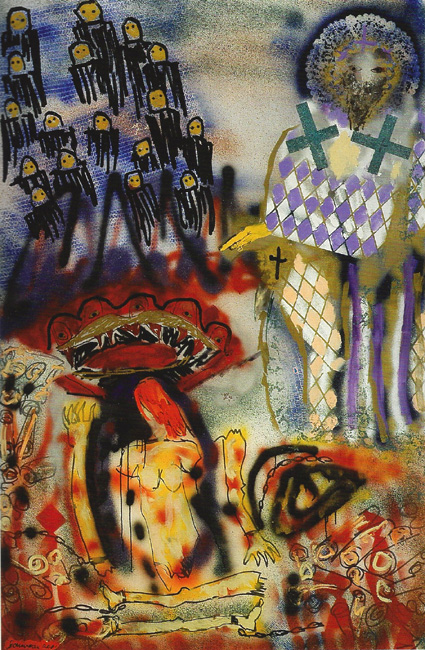Source: WTL© photograph from Pierre Gauvreau; Passeur de modernité, p. 155.
Image: "Les Insoumis No. V: Hypathie, philosophe païenne et martyre (370-415)" [The Unsubdued No. V: Hypatia, pagan philosopher and martyr] (2001). Acrylic and felt on canvas.
Comments: This dynamic and very complex painting refers to another historical victim of violence against reason and freedom of thought: Hypatia of Alexandria (c. 360 - 415; in Greek: Ὑπατίᾱ Hupatíā with a stress on the final "i") was a Greek woman astronomer, philosopher, mathematician, and teacher in the Neoplatonic school of Alexandria's (Egypt), which was part of teh Byzantine Empire. In fact, it is likely that Hypatia used the scientic methods of her time to research and propose both a heliocentric model of the solar system and a model of stars' elliptical orbits. Hypatia was captured, stipped naked, tortured, murdered, and burned by a mob of Christian monks and fanaticized zealots who were inflamed by a rumor that she was the cause for the political and religious conflicts between the Jews, Christians (and Cyril, the Christian bishop of Alexandria), and pagans of Alexandria, whose pagan governor was Orestes. The painting combines all of these main elements in a mixed media work that shows clear postmodern characteristics. Compare, for example, the figure in the upper right corner with this icon of Cyril of Alexandria (376 - 444):
A fine movie version of Hypatia, her intelligence, her theories, her moderation and tolerance, and the civic violence that led to her tragic death as a martyr for reason is depicted in the 2009 movie, Agora (Rated R), directed by Alejandro Amenábar and starring Rachel Weisz.
Humanities Questions: Analyze and react to this painting mentioning three main humanities aspects as you choose them.

